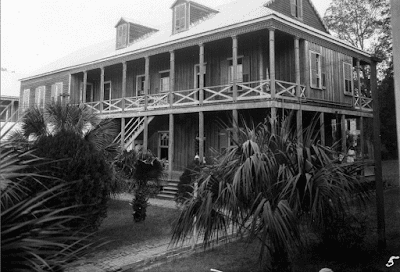Chinchuba was the Choctaw word for alligator, and the area where the school began is now occupied by several shopping centers at the intersection of U.S. 190 and La. Hwy. 22.
Mandeville post office is located today. The famous "Chinchuba Oaks"
were located in the area. Click on the map to see a larger image.
According to the article, the school was the only school for deaf-mutes in the far South. It was founded in 1890 by the Very Rev. Canon H. C. Mignot, a well-known and beloved pastor of the St. Louis Cathedral, and the Archdiocese of New Orleans. Father Mignot's attention was called to the fact that nothing was being done for Catholic deaf-mutes in the South, and he thus entered "heart and soul" into the project.
An early and lifelong supporter of the project was Archbishop Janssens who gave the work of the Institute his hearty approval, and all the help he could.
To give the Institute a home, Father Mignot (with the assistance of a few friends) purchased a large tract of land together with the old plantation home, known as "Kildare House." He saw to it that the necessary improvements were made, and then placed the school in charge of the Dominican nuns, the teachers coming from the famous institute in Cabra, Ireland.
The school prospered, but after two years the nuns of St. Dominick retired and the School Sisters of Notre Dame took their places in response to a call from Archbishop Janssens. Father Mignot during his lifetime supported the school almost entirely himself with the exception of help given by a few friends.
And the institute did continue, under the late Most Rev. Archbishop Blenk and when the Most Rev. Archbishop Shaw succeeded him, he was so deeply touched at the nobility of the cause that he made it a Diocesan Work.
Up to that time, few efforts had been made to help deaf-mutes in the South, due to the difficulties of communication and education. The article stated that for more than a quarter of a century, the school had steadily progressed, despite many challenges, due to its "underlying spirit." Supporters arose to meet almost any need it seemed.
Although the Chinchuba Institute began under Catholic auspices, it extended a cordial welcome to deaf-mutes of other denominations. Apart from requiring the observance of the rules of discipline, the Sisters conscientiously respected their Faith, according to the report.
The education which the children received was "modern" for the times and thorough in every detail, according to the article. The Sisters had been trained in the latest methods of deaf-mute education. "In conformity with the present method, every effort is made to teach the pupils the art of speech and lip-reading. Their progress is very gratifying alike to teachers and pupils, and encourages the hope that the latter will be all the better able to earn an honorable livelihood when they leave the Institute," it was explained.
Thanks to the donation of a well equipped printing department to the Institute, students were able to learn the printing trade at the direction of one of the Sisters. The occupational training feature appealed very strongly to Institute leaders as a means to prepare the pupils, especially the boys, to become successful in life. "The most practical activity is to help people to help themselves," the article stated, calling upon additional "generous benefactors" to be sent to furnish the means to start other trades.
In 1919 the Chaplain Rev. Joseph M. Coulombe began the gradual development of a farm. Although weather conditions were very unfavorable, much was accomplished that first year. The rice crop, the first ever raised there, was very good. The farm was well stocked and well-equipped with modern farming implements, and it was hoped that the farm, with its crops (potatoes and other vegetables, corn and rice for the table, feed for the cattle, hogs, horses and poultry) would be helpful in reducing the Institute's expenses.
---------------------------
End of excerpts from the 1920 Morning Star article.
Here are some photographs from the Louisiana Digital Archives showing the students, faculty, and buildings at the Chinchuba Deaf Mute Institute.
Even though the outlook was rather bright at that time (1920), the Institute was still very much in need of funds to carry on its work. The facility was hit by a devastating fire in 1934. Click on the articles to make them larger.
It continued to serve the needs of its community for many years, changing as needed to meet the demands. However, due to lack of funding, it was shuttered in 2010, leaving a legacy of over 120 years serving the special needs children of the entire region.









































